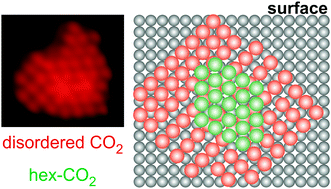Common structures of CO2 on structurally different coin metal surfaces
Abstract
We investigate superstructures formed by CO2 on Ag(100) and Cu(111) from small clusters forming at 21 K up to multilayers grown at 43 K by low temperature scanning tunneling microscopy. On both surfaces, CO2 nucleates only at defects, here at co-adsorbed CO. At the lower adsorption temperature, superstructures of different symmetry coexist on both surfaces at submonolayer coverage, while the superstructures formed at the higher adsorption temperature differ largely for the two surfaces. On Ag(100), the CO2 monolayer exhibits a long-range order interrupted by antiphase domain boundaries. On Cu(111), a random distribution of domain structures of different symmetry leads to a monolayer without long-range order. Surprisingly, the degree of ordering is inverted for the 2nd layer of CO2. On Ag(100), the coexistence of different superstructures in the 2nd layer leads to reduced long-range order. On Cu(111), a hexagonal 2nd layer exhibits long-range order. A layer of a similar superstructure, hexagonal with long-range order, exists as the 3rd layer of Ag(100). Despite the different substrates, a multitude of common structural features of CO2 exist. Hexagonal layers grow with a long-range order on less ordered layers on both surfaces. Our results suggest that the preferred structure of a CO2 layer is hexagonal.

- This article is part of the themed collection: 2019 PCCP HOT Articles


 Please wait while we load your content...
Please wait while we load your content...